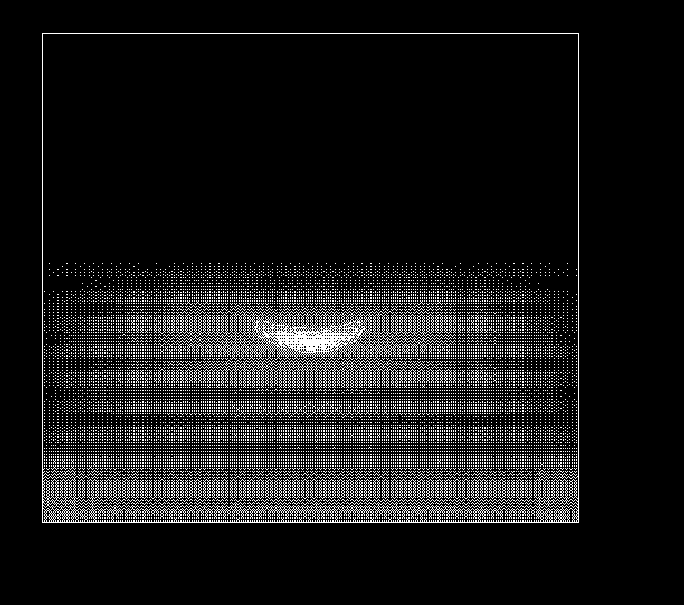
Stars are born deep inside dark molecular clouds which shroud the process, making it difficult to observe. Helen Pongracic and Sue Byleveld are using numerical simulations to shed some light on star formation.
Stars are born in dense regions inside giant molecular clouds (GMCs), which are clouds of hydrogen gas and dust between stars. The internal pressure of the clouds prevents them from collapsing in on themselves due to their own gravity, therefore some external cause is needed to induce a section of the GMC to collapse and form stars. A compression wave, or shock, can produce localized regions of high density which may then collapse under their own gravity. A flattened spinning disk of gas and dust is formed, with the material gradually moving to the centre of the disk to form a spherical core, called a protostar. As the core contracts it heats up. A new star is born if enough material accumulates in the core to turn on nuclear fusion, the process which provides the star's energy. Shocks in GMCs can be caused by two GMCs colliding, by the collision of two or more clumps within a GMC, or by a supernova explosion near or within the cloud.
Important questions concerning star formation remain unanswered. How dense must a region be before a star will condense out? What triggers the collapse? Why are there more multiple star systems, where two or more stars are gravitationally bound, than single stars like our Sun? How important are magnetic fields during the collapse which leads to star formation?
These questions are difficult to answer observationally. A protostar is not as hot and bright as an ordinary star, and it is cocooned in the gas and dust that are still falling onto the spinning disk. Protostars are therefore hard to see from the Earth in visible light, although they can now be observed more easily due to recent advances in infra-red detector technology.
Helen Pongracic and Sue Byleveld, a PhD student, are using numerical simulations to investigate the condensation of protostars out of interstellar clouds. This involves using a three-dimensional hydrodynamical code that incorporates gravity. This code was developed by Helen Pongracic and collaborators at the University of Wales, Cardiff.

Figure: Results of a simulation of a supernova shock compressing a stable cloud.
The greyscale indicates the density - black being the most dense.
The contours indicate column density (density integrated through the region
perpendicular to the plane of the page).
The supernova shock moves from left to right and is seen as the grey-white boundary.
The cloud is initially spherical and is compressed by the shock.
The crescent is a bow shock which has formed around the cloud.
The compression of a cloud, or section of cloud, by a shock, is simulated to see if a protostar results. It is found that the compressed regions can condense to form flattened spinning disks with high density cores that could be interpreted as protostars. As the gas is compressed by the shock it heats up, and in a real GMC some of this heat would be radiated away, cooling the condensing core. In the simulations protostars are formed more readily when cooling is included than when no cooling is allowed. In 1993 Helen completed the first 3D simulations incorporating both gravity and cooling of a supernova shock interacting with a molecular cloud.
At least fifty percent of the stellar systems surveyed are multiple systems so a realistic simulation should produce multiple protostars orbiting around one other. Simulations by a collaboration including members of the Cardiff group and Helen Pongracic showed that if two clouds or clumps collide head-on, only single protostar systems result. However, when two clouds or clumps collide off-centre, introducing some rotational motion to the system, the simulations show that multiple protostar systems can be formed, in accordance with observations.
Magnetic fields are observed in star-forming regions, and researchers involved in star formation are divided over the importance of magnetic fields in this context. A considerable amount of work has been done on the effects of magnetic fields on the latest stages of star formation, after the protostellar disk has formed. The effect of the magnetic field has also been considered in the slow collapse of single clouds. However, little is known of the influence of magnetic fields on the early stages of violent collapse such as that initiated by cloud collisions or compression by supernova shocks. Magnetic fields help support molecular clouds against collapse. Analytic work on shock structure by Sue Byleveld, Don Melrose and Helen Pongracic, suggests that although it is more difficult to achieve the high compression necessary for star formation when a magnetic field is present, it is still possible. Sue Byleveld is generalizing the 3D hydrodynamical code originally developed at Cardiff to include the effects of magnetic fields. The new code will be used to determine the extent to which the magnetic field influences the collapse leading to star formation.
The molecular clouds in Orion are observed to be regions of prolific star formation. Recent infrared and optical observations of Orion, by Dr David Allen (Anglo-Australian Observatory) and Dr Michael Burton (University of NSW), show mysterious `bullets' which appear to be emanating from a common centre. Helen and collaborators from the University of Iowa hope to determine the origin of these bullets by modelling them as explosive events. Initial simulations have managed to reproduce the bow shock structure observed, but not yet the observed velocities.